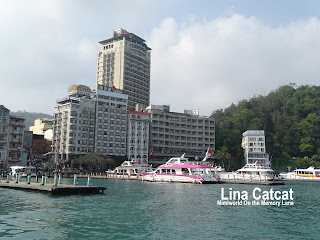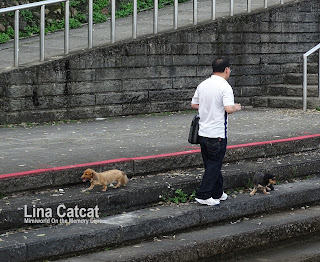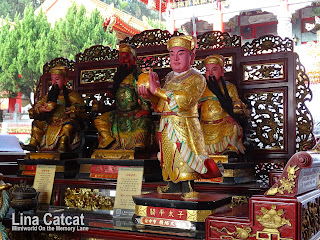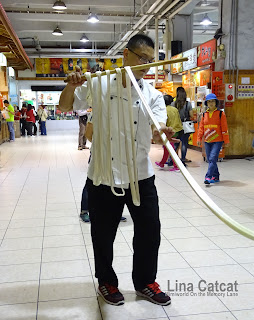
Alishan Sunrise
After we had travelled Alishan Forest railway and Sister Ponds on 11th April. Next day in the early wee in the morning at 4.30 am, we had to board Alishan train however, we had missed the Alishan Sunrise 阿里山日出 at Zhushan Station where there is a viewing platform. Because it was raining yesterday at that time. So I guess it would be a waste trip to see a sunrise in vain, only to see sea of clouds, stood out the freezing cold weather about 10 degrees. A train travels would take about 30 mins to reach Zhushan station. I think the train costs NT$100 one way or NT$150 (to & fro). But we had a complimentary ticket and it was given by group leader.
Alishan Town Center
Behind this tall plaque, is the Alishan Railway station where we walked up the staircase on the right and we boarded a train to watch sunrise at Zhushan view platform at 5.30am. On top of the tall plaque which was shown - 10 degrees at 7.00am. That was cold weather here in Alishan.

Puli Brewery Factory
From promoting the culture of Shao-xing Wine, there are also putting more efforts in preserving the history of the wineries.
Main Entrance to Wine&Snacks stalls
We went straight to the wine ice-cream stall that sells various types of ice-creams that we love most - Red bean ice-cream as they don't have durian ice-cream because they don't make it.

Wine ice-cream stall

Wine Red Bean ice-cream
We bought a wine ice-cream - wine red bean (as above) costs about NTD15.

Stalls that sell local products
There are lots of stalls that are selling Taiwan tea eggs, ramen, sugar cane, lots of duck parts, different sauces, snacks and other local products. You can get a taste for some of the favourite snacks in Taiwan.

Demonstration sugar cane candy
Minutes later, we stood in awe and looked at a guy demonstrating his 'Gongfu' skill on sugar cane candy as crowded gathered. Puli is also popular for its sugar cane, you might want to try this non-alcoholic sugar cane candy. It is crunchy like a biscuit but doesn't sticks to our teeth but if you put it to your mouth and it melts easily.
Two packs of Sugarcane candy
A bag of sugar cane candy cost NTD80 [approx. $3.40 SGD]. So we bought sugar cane use for coffee and desserts.
Main Entrance to Wine Museum
The Puli Brewery (埔里酒廠) is a large complex in the heart of Puli. It is famous for brewing Shaohsing Wine, a pungent yellowish alcohol that’s not for the faint of heart.
Puli Wine Factory is located in Nantou county with clean sweet water and excellent weather conditions which allows it to produce this specific type of rice wine. Puli is known for the 4W’s – wine, women, water and weather. Although the original Puli Brewery factory was also destroyed in the 921 earthquake, it has thrived in the face of hardships to become a popular destination.
Puli Wine Factory is located in Nantou county with clean sweet water and excellent weather conditions which allows it to produce this specific type of rice wine. Puli is known for the 4W’s – wine, women, water and weather. Although the original Puli Brewery factory was also destroyed in the 921 earthquake, it has thrived in the face of hardships to become a popular destination.
Puli Brewery is famous for its Shao-xing Wine (紹興酒). Shao-xing is one of the 10 famous liquors in Chinese history. It is made from sticky rice, Penglai rice, and wheat. Puli Shao-xing is also famous for the spring water used to make the wine. After fermenting the wine, the wine masters store it in a chamber to mature until it’s ready to be enjoyed. A typical Shao-xing is a three-year ripe wine, but there are also five year, seven year, and even top-tier ten year or more wines.
Wine Pots and Jugs with poles
This golden liquor has won several awards around the world. When you open the bottle, you will be amazed by its pure and strong fragrance. You may drink it hot in winter for a stronger aroma, or cold with ice in summer for a refreshing taste. Even for people like us who don’t drink much, there are dozens of products made from Shaoxing, such as Shao-xing rice cakes, ice bars, tea eggs, candies, and even instant noodles. There is also a small temple memorialising the wine god Dukang. Wine lovers would do well to tip their hat in thanks to him.
Story of Taiwan Shao-xing
We went through the museum which is steeped with history. We can learn all about the importance and significance of beer and wine in Taiwanese culture dating back to hundreds of years ago. It was good to learn about Taiwan’s perspective of alcohol and the traditions such as when a family gives birth to a boy, they put a jug in the cellar and open it when he gets married.

Traditional Wedding Wine

Wine Pots On Display
Even though we don’t get to see how they make their wine, it is interesting to see lots of wine jugs display in the museum. The best part is sampling the different alcohols and snacks they have.

Jugs with Pole

Carrying poles with jugs
The "huge" jugs they used to store the wine. When we went through this area, you can try and pick up one of the carrying poles with jugs on either end. Well, I did it.
Colourful painted wine pots

Pavilion

Closeup: Pavilion
This Pavilion is located outside the Puli Brewery where visitors relax.

Love or Romance 爱情

招财 Inviting wealth
Outside the Brewery, there are lots of wine pots placed on the ground, written in Chinese characters.
Cien Pagoda was built in 1969, finished in 1971, and in memory of Chiang Kai-shek’s mother and Cien means kindness, grace and mercy. From the parking lot to Cien Pagoda, it’s about 570 meters and there is a number on the stone stairs for every hundred meters. Cien Pagoda is located above 954 meters sea level, and the pagoda is 46 meters high. Combined these two height and we know the height of peak of the pagoda is 1000 meters. It’s the highest architecture in Sun Moon Lake. I heard from sources that there's a legend folkore story about Sun Moon Lake.We had enjoyed a 1.5 hr private motorboat cruise on the beautiful emerald waters of Sun Moon Lake, Taiwan’s largest body of water and we were able to see lots of beautiful scenery during cruising and here we had seen as below.

Shuishe hub for tourists on the go

Rock island - A stone-crafted ReinDeer rock is seen

Closeup: Reindeer is seen on the a rock
It is believed that Gaoshan people found Sun Moon Lake because of a Reindeer. Legend has it and it is beautiful legend to be told. Over 300 years ago, 40 local people were hunting for food and a huge white reindeer appeared in front of them. They were astonished and hunted it for three days and nights but to no avail. On the fourth day, they went through the woods and were shocked by the amazing scenery before their eyes. A lake was embraced by lush mountains and forests. There was an island in the center of the lake dividing it into two parts, like a sun and a moon respectively. So they named it “Sun Moon Lake” and the island “Zhuzi Island” because it looked like a precious jewel that looked into their eyes.
There are Owls within Sun Moon Lake/ Legend has it that the owl is the incarnation of a young woman who got pregnant out of wedlock and died in the mountains. To make amends, the Thao do not kill the owls when they see it as a good omen for pregnant women.
A fishing net
Another legend has it and a story was told by Thao Tribe, there was once a time when strange beings lived at the bottom of the Sun Moon Lake. The upper part of the body was like a human and bottom part of the body like a fish, their thick hair hung over the faces, flowing down to their chests and backs. And they spend all day in swimming and enjoyed at the bottom of Sun Moon Lake. Thao Tribes people who lived in the village called the strange beings "Taqrahaz". Ever since the Thao people settled at Sun Moon Lake and got along very well with Taqrahaz. Like the Thao people, Taqrahaz depends on fish, shrimps and mollucks of the lake for their livelihood. Over 10,000 years, they gathered all the fishing but didn't treasure the abundance of life at the lake. Thao tribe's net was damaged and one of the tribe people dive into the deepest water of the lake and to find out what was happening. He saw Taqrahaz breaking the holes of eel buckets and nets. He got angry and fought with Taqrahaz for 3 days & 3 nights. Their thrashing that stirred up the waters and waves washed over the hill and lake. Thao people realised and learned their lesson when Taqrahaz said about the importance it is for them and Taqrahaz that life must be sustained. They set their rules as to what kind of fishes to be hunted and at what time of the year. The small fishes should be put away for offsprings. The Thao people took care of Sun Moon Lake to ensure that the area were undisturbed and the shrimps and fishes would feed and breed. After Thao people learned their lessons, they left Sun Moon Lake so that the life of the lake would flourish. 
Wenwu temple@Sun Moon Lake
While cruising along sun moon lake and we saw Wenwu Temple at the top of the mountain. before we reached the Zhaowu pier which is close to Shuishe village.

Sun Moon Lake plaque

Upon reaching the pier
Our crusise stopped at Zhaowu pier and walked the step to board the bus to Wenwu temple.

Cute dogs@Sun Moon Lake
Before we walked up the stairs, we saw two cute dogs belonged to the man (shown in pic) walked around the steps next to the river as if his dogs were not afraid of being fall off into the river.

Wenwu Temple 文武廟
Wenwu Temple 文武廟 also known as Sun Moon Lake Wenwu temple , is located at the shoulder of a mountain on the north of Sun Moon Lake. Originally, there were two temples on the Sun Moon Lake coast called "Longfeng Temple and Ihuatang of Shuishotsun". During Japanese government time, they built a dam to generate electricity using the lake, causes the water level raised up.

Wenwu Gateway and Ceremonial Arch
We were greeted by the towering dark green Memorial arch entrance.The main entrance of “Gateway and Ceremonial Arch” is a northern style monumental archway. Its main gate is facing to the North of the Sun Moon Lake.

Wenwu temple hit by 7.3 earthquake in 1999
Photo Credit: Wenwu Temple
The Wenwu temple 文武廟 has its history of the past. In 20th Sept 1999 that morning, an earthquake measuring 7.3 on the Richter scale shook the entire country and people were called it "921 earthquake 九二一大地震" also known as Jiji earthquake 集集大地震. Its epicentre was 7.5km underground and 6.5km southwest of Sun Moon Lake. Over 2,300 people were killed and 39 went missing across Taiwan. Around Sun Moon Lake, large hotels crumbled. Wen Wu Temple (文武廟), one of the most popular sites, was destroyed but one of the powerful main hall nearly stopped earthquake from being further damage to the hall. Kuanghua Islet (光華島), another popular site, split in half. Tsen Pagoda (慈恩塔) was knocked sideways. As you can see the picture (above) the 7.3 earthquake moved straight the central hall until it stopped abruptly and it turned to the right before hitting to the small hall on the sideways and it damaged to the building due to the tremor or shake violently on the ground.

Crack in recent earthquake in 2013
In 2013, another 6.7 maniearthquake caused an archway in the historic Wenwu Temple to collapse, but no one was injured because of the damage. As you can see the "crack" on the ground of the temple which I presume it would be the earthquake that caused it.
Two Old Temples torn down
Photo Credit by: Wenwu Temple
The two temples were then torn down and rebuilt at the present location of Wen Wu Temple in 1938.

Front Hall

Vermilion Stone Lions
Outside in from of the main hall, there are two Red vermilion stone Chinese lions statues 麒麟 (above) on the two sides of the front plaza that guarding the temple of the two side of Plaza. They were donated by Wu Huo-shih, the late chairman of the Shin Kong Life Insurance Company, whose name meant "fire lion." It is the only Chinese lion 麒麟 statue in RED in Taiwan due to the sponsor's name that is related to "FIRE".

Tortoise holding an Arch
The small dragon Tortoise 龙龟 statue which is carrying an arch on its back as seen above.

Middle door is entered by gods
This is the only Confucius Temple in Taiwan that keeps its central door open. Temple officials say that they do this because the temple is on the bank of Sun Moon Lake and has many tourists, so they keep the door open for the convenience of the visitors.
Actually there are 5 heavenly doors for big temple like Wen Wu Temple 文武庙. The middle door is enter by gods, tourist is not allow to enter. We, the human, enter the temple from right door and exit from the left door. There are door gods from behind each door

Actually there are 5 heavenly doors for big temple like Wen Wu Temple 文武庙. The middle door is enter by gods, tourist is not allow to enter. We, the human, enter the temple from right door and exit from the left door. There are door gods from behind each door

Huge Burner outside First hall
The temple consists of three separate halls.
God of Literature 文昌帝君
The first hall "The Water and Cloud Hall" is shrine hall and is devoted to the First Ancestor Kaiji - God of Literature.

Hand painted and hand carved on the ceiling

Closeup: Dragons and Gods
The building are entirely hand-painted and hand-carved by expert craftmen and they didn't use nails to build it. Upon hearing this, made the vistors jaw-dropping.
Green Dragon Sculpture@Da Cheng Hall
The Martial Sage hall is devoted to Guan Gong 關公 , the God of War and the warrior-God Yue Fei 岳飞 . The third and final hall "Da Cheng Hall" is dedicated to Confucius 孔子.
A step to Stairway to Heaven
Before the lake road was built, the only way to get to Wunwu Temple was to take a boat to the pier below the temple and climb up a very steep flight of steps.
Year of Steps platform: 1st day of each month
In early days, these steps were called the "stairway to Heaven." Completion of the road made it far easier for travellers to reach the temple, and the steps below the temple were gradually forgotten.
They recently renovated the steps and are now 366 steps covering the 150-meter distance, symbolizing the 366 days in a year (including an extra day in leap year). At the step that represents the first day of each month (see above), a platform where people can stop and rest. Information related to the 24 solar periods is also carved into the steps, so that visitors can learn something about China's traditional folk culture as they slowly ascend the steps. The steps are now known as the "Year of Steps at Wunwu Temple", and make a very interesting visit.
Wind Chimes
There are also wind chimes along the steps, which are used by visitors to ask for blessings.
Tribes played music
Outside the Arch, saw these two guys wear tribe uniforms, play music and songs. If you want to take a photo with them and the box in front of them is donation box. And of course, you put some notes or coins into their box if you wish to.

A view of Sun Moon Lake
As we look into the view of Sun Moon Lake (pic as above) that takes in all of the natural and culture sights that surround it. On the right side of the lake that hardly seen and covered by mist of clouds, is the Shuishe Village and Zhaowu pier (wharf) where we docked at the pier earlier. There is a Lalu Island (far centre), a sacred place to the Thao tribes, one of the aboriginal tribes in Taiwan.

2-story Hotel
Later we proceeded to the restaurant located nearby, stands 2-story hotel, there is a restaurant and a hotel lobby. When entering the hotel, there is a Piyao statue at the hotel counter at the corner.



Statue of Piyao@hotel
At Wenwu temple, there is a statue of Piyao or Pixiu (I often call it) as it often lookalike, a symbol of blessing for wealth and good luck. And it also protects and safeguards homes, temples, shops, buildings and so on from dangers. For people especially businessmen who often embark on long journeys, it is best to constantly wear or carry a Pi Yao amulet. This is said to serve as protection from injuries and accidents, and guarantee victorious voyages with many business opportunities. Some people also wear Kuan Yin (made of jade) round their neck for protection from road accidents and keep away from bad luck. Statue Piyao (Pixiu) is often seen with a note or a red packet in its mouth is located at temples, shops and buildings in Taiwan.

Pixiu@Wenwu temple

closeup: Pixiu statue
Well, at home, I have a good luck money toad redstone with a coin in its mouth, a good luck dragon turtle redstone with a coin in its mouth and also have a antique gold three ChanChu Money Frogs sphere stand with a clear 2" crystal ball (separate lucky coin in their mouth) and a Piyao (Pixiu) too. The Chinese have always admired and respected this extremely good luck symbol. It is a very loyal creature, and is said to always attempt to rid its owners life of bad luck and replace it with wealth. So do you? If you want your home or yourself to be blessed for good luck, wealth, protection and prosperity, get one for yourself.











No comments:
Post a Comment